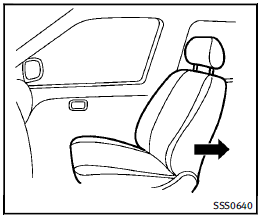Booster seats

Precautions on booster seats
 WARNING
WARNING
If a booster seat and seat belt are not used
properly, the risk of a child being injured in
a sudden stop or collision greatly increases:
► Make sure the shoulder portion of the
belt is away from the child’s face and
neck and the lap portion of the belt does
not cross the stomach.
► Make sure the shoulder belt is not
behind the child or under the child’s
arm.
► A booster seat must only be installed in
a seating position that has a lap/
shoulder belt.

Booster seats of various sizes are offered
by several manufacturers. When selecting
any booster seat, keep the following points
in mind:
► Choose only a booster seat with a label
certifying that it complies with Federal
Motor Vehicle Safety Standard 213 or
Canadian Motor Vehicle Safety Standard
213.
► Check the booster seat in your vehicle
to be sure it is compatible with the
vehicle’s seat and seat belt system.

► Make sure the child’s head will be
properly supported by the booster seat
or vehicle seat. The seatback must be at
or above the center of the child’s ears.
For example, if a low back booster seat
1 is chosen, the vehicle seatback
must be at or above the center of the
child’s ears. If the seatback is lower
than the center of the child’s ears, a
high back booster seat 2 should be
used.
► If the booster seat is compatible with
your vehicle, place your child in the
booster seat and check the various
adjustments to be sure the booster
seat is compatible with your child.
Always follow all recommended procedures.

All U.S. states and Canadian provinces or territories require that infants and small children be restrained in an approved child restraint at all times while the vehicle is being operated. The instructions in this section apply to booster seat installation in the rear seats or the front passenger seat.
Booster seat installation
 CAUTION
CAUTION
Do not use the lap/shoulder belt Automatic
Locking Retractor (ALR) mode when using a
booster seat with the seat belts.
Refer to all Warnings and Cautions in the “Child safety”, “Child restraints” and “Booster seats” sections earlier in this section before installing a child restraint. Follow these steps to install a booster seat in the rear seat or in the front passenger seat:

1. If you must install a booster seat in the front seat, move the seat to the rearmost position. 2. Position the booster seat on the seat. Only place it in a forward-facing direction. Always follow the booster seat manufacturer’s instructions.

Front passenger position
3. The booster seat should be positioned on the vehicle seat so that it is stable. If necessary, adjust or remove the head restraint or headrest to obtain the correct booster seat fit. If the head restraint or headrest is removed, store it in a secure place. Be sure to reinstall the head restraint or headrest when the booster seat is removed. See “Head restraints” earlier in this section or “Headrest” earlier in this section for head restraint or headrest adjustment, removal and installation information. If the seating position does not have an adjustable head restraint or headrest and it is interfering with the proper booster seat fit, try another seating position or a different booster seat. 4. Position the lap portion of the seat belt low and snug on the child’s hips. Be sure to follow the booster seat manufacturer’s instructions for adjusting the seat belt routing. 5. Pull the shoulder belt portion of the seat belt toward the retractor to take up extra slack. Be sure the shoulder belt is positioned across the top, middle portion of the child’s shoulder. Be sure to follow the booster seat manufacturer’s instructions for adjusting the seat belt routing. 6. Follow the warnings, cautions and instructions for properly fastening a seat belt shown in “Seat belts” earlier in this section.

7. If the booster seat is installed in the front passenger seat, push the ignition switch to the ON position. The front passenger air bag status light may or may not illuminate depending on the size of the child and the type of booster seat used. See “Front passenger air bag and status light” later in this section.
See also:
Setting memory function
The position of the following settings can be linked to the Intelligent Key and the memorized settings can be available for each Intelligent Key.
● Climate control system
● Navigatio ...
Window washer fluid
WARNING
Antifreeze is poisonous and should be
stored carefully in marked containers out
of the reach of children.
Fill the window washer fluid reservoir
periodically. Add window washer flu ...
INFINITI Advanced Air Bag System (front seats)
Sedan
1. Crash zone sensor2. Supplemental front air bag modules (INFINITI Advanced Air Bags)3. Front seat-mounted side-impact supplemental air bags4. Occupant classification sensor (pattern sensor) ...
